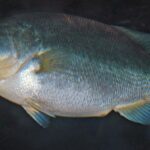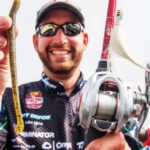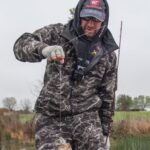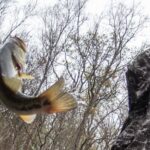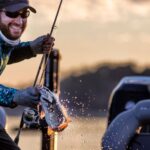Editor’s Note: There’s no question that tackle does make a difference. New innovations, depth finders, lures, rods, reels and other equipment are allowing professional fisherman to catch as many or more bass than they have in the past. One of the most-consistently successful pros is Ott DeFoe, winner of the 2019 Bassmaster Classic and ranked third in the world, with earnings of $2.7 million according to BassFan (http://www.bassfan.com/). Ott DeFoe explains that, “The equipment that bass fishermen use are tools. To be the best you can be, you’ve got to use the best tools for every fishing condition that you’ll face when on the water. A carpenter won’t use a tack hammer to drive a tenpenny nail or a big hammer to drive a finishing nail. So, over the years, fishermen have learned which equipment is best to use when fishing certain lures under specific conditions to get bass in the boat. This is the reason different lengths and types of rods are needed for various kinds of lures and places where we fish those lures.” To learn more about Ott, visit his Facebook page at https://www.facebook.com/ottdefoe/.
 Today, anglers have basically three choices in line: braided, fluorocarbon and monofilament. The line I use most of the time is fluorocarbon, braided is my second choice, and monofilament is my last pick. I choose fluorocarbon first because it has just a little bit of stretch. However, the main reason that I fish fluorocarbon is because it’s the most-invisible line on the market today, and I think it has a big effect on whether a bass will take a bait or not. Monofilament has so much stretch, which can cause an angler not to get the hook deep in the bass’ mouth as he needs it to be to land the fish. Then an angler may lose more bass than he should.
Today, anglers have basically three choices in line: braided, fluorocarbon and monofilament. The line I use most of the time is fluorocarbon, braided is my second choice, and monofilament is my last pick. I choose fluorocarbon first because it has just a little bit of stretch. However, the main reason that I fish fluorocarbon is because it’s the most-invisible line on the market today, and I think it has a big effect on whether a bass will take a bait or not. Monofilament has so much stretch, which can cause an angler not to get the hook deep in the bass’ mouth as he needs it to be to land the fish. Then an angler may lose more bass than he should.
For this reason, I fish fluorocarbon 60-70% of the time when I’m bass fishing. Ninety percent of the time when I’m fishing spinning tackle, I’ll use braided line with a fluorocarbon leader, and 15-20% of the time when I’m using bait-casting tackle, I’ll use braided line either with or without a fluorocarbon leader. The reason I like braided line for spinning tackle is because it doesn’t have any twist in the line, often called memory. (Memory is defined as the line remembering the coils that it had when it was spooled onto a spinning reel). So, when you cast, instead of coming straight off the spool, the coils in the line will slap the guides on the rod, reducing the length of the cast. But with braided line, you don’t have to deal with coil slap, and it doesn’t have any stretch. Also, today braided line is much smaller in diameter than the braided line your dad and or granddad once fished, which enables you to make longer casts too because there’s no stretch in the line. You can get a much-harder hook set, even if the bass bites well away from the boat.

With spinning tackle, we fish quite a few small baits, and I can cast those baits so much further with braided line than I can with monofilament. Today’s 10-pound braided line is about the same diameter as 2-pound-test monofilament line, and my casts are so much further with braided line than they will be with a fluorocarbon line.
When I’m fishing spinning tackle with braided line and using a fluorocarbon leader, I use the FG knot (https://www.youtube.com/watch?v=AQdVKXgLwI) to make that connection between the fluorocarbon and the braided line. The FG knot is the strongest knot I’ve found for making this type of connection – whether I’m using a 10-pound braided line with a 6-pound-test fluorocarbon leader or 50-pound-test braided line tied to a 20-pound test fluorocarbon line. Although this knot is not necessarily the easiest knot to tie, I’ve tied it so much that I can do it fairly quickly now.
After I make that connection of the fluorocarbon to the braid, I like my fluorocarbon leader to be about 12 feet of 6-pound-test fluorocarbon tied to 10-pound-test braided line. But occasionally I’ll use 12-pound-test fluorocarbon line and shorten my leader by about 5 or 6 feet. If I’m using a fluorocarbon leader and 50- or 60-pound-test braided line on my bait-casting reel, I won’t have more than 5 or 6 feet of fluorocarbon leader line.
I use monofilament line when I’m fishing in the wintertime with a small crankbait on spinning tackle because when the weather’s very cold outside, and you have to worry about your line freezing-up or getting ice in the guides of your rod. The braided line on spinning tackle then will become a popsicle (freeze-up because it absorbs water), and you can’t cast the braided line at all. Too, fluorocarbon can become extremely brittle in really-cold weather. So, during the winter is the only time I can think of that I fish with monofilament line.
In past years, common knowledge was, “You need to fish monofilament line when you’re fishing a crankbait because the monofilament gives in and allows the bass to suck the crankbait deeper into its mouth than other lines do.” The way I’ve solved this problem, so I don’t have to use monofilament line is I fish with a composite rod called a cranking stick from Bass Pro Shops that’s a softer rod (bends more) than my other rods do. This way I get some of the benefits of monofilament on the rod rather than having so-much stretch in the line that I can’t get a solid hook set. Most of the fish that I’ve ever lost with monofilament has been because I wasn’t able to drive the hook deep enough in the fish’s mouth to have a solid hook set.
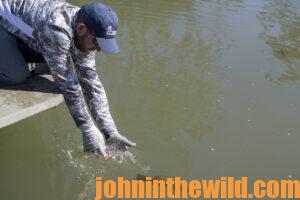 Tackle to Pack for Long Times Away from Your Home Base:
Tackle to Pack for Long Times Away from Your Home Base:
Another question I’m often asked is, “How many rods, reels, lines and lures will you carry with you when you’re going to tournaments for two or three months at a time?” I carry tackle in both my boat and truck, and most of the time I’ll have more than 35 rods and 35 reels in both my boat and my truck. I’ll carry one spool of 1,000 yards in different sizes of line in my truck. For example, I’ll have 6, 10, 12, 20 and several other sized spools of 1,000 yards of braided line and several hundred pounds of other tackle, including lures weights, sinkers and assorted other tackle I may need. I have a tackle tray in the bed of my truck and places for more lures in my boat. If I had to guess, I’ll probably have somewhere between 15,000 and 25,000 different bass lures of all shapes, sizes and colors in my boat and my truck when I’m going to be fishing multiple tournaments before I return home.
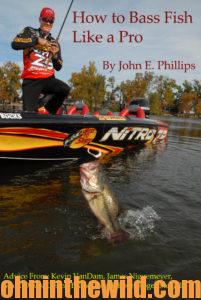 To learn more about bass fishing, check out John E. Phillips’ book, “How to Bass Fish Like a Pro,” available in Kindle, print and Audible versions at https://www.amazon.com/gp/product/B007RP2LZS/ref=dbs_a_def_rwt_hsch_vapi_taft_p2_i2
To learn more about bass fishing, check out John E. Phillips’ book, “How to Bass Fish Like a Pro,” available in Kindle, print and Audible versions at https://www.amazon.com/gp/product/B007RP2LZS/ref=dbs_a_def_rwt_hsch_vapi_taft_p2_i2
You may have to copy and paste this click into your browser. When you click on this book, notice on the left where Amazon says you can read and hear 10% of the book for free. On the right side of the Audible page for this book and below the offer for a free Audible trial, you can click on Buy the Audible with one click.
Tomorrow: Ott DeFoe Talks Bassing Rods





